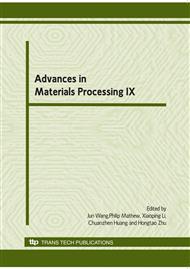p.134
p.140
p.146
p.152
p.158
p.164
p.170
p.177
p.183
Fabrication of Ultrafine Grained Copper Alloy by 3-Layers Accumulative Roll-Bonding Process
Abstract:
The 3-layers accumulative roll bonding process (ARB) has been attempted to increase the strength of copper alloy (Cu-0.02wt.%P) by refining grain size. The 3-layers accumulative roll bonding was conducted up to 7 cycles at room temperature without lubrication. Microstructural evolution of the copper alloy with the number of the 3-layers ARB cycles was investigated by optical microscopy (OM), transmission electron microscopy (TEM), and electron back scatter diffraction (EBSD). The average grain size has been refined from 20 μm before ARB to 170 nm after 7 cycles of 3-layers ARB. More than 70% of ultrafine grains formed by 3-layers ARB were composed of high angle grain boundaries. The average misorientation angle of ultrafine grains was 30.7 degrees in the center of the specimen. Tensile strength after 7 cycles of 3-layers ARB was 605 MPa, which is about 3.2 times higher than the initial value.
Info:
Periodical:
Pages:
158-163
Citation:
Online since:
June 2010
Authors:
Price:
Сopyright:
© 2010 Trans Tech Publications Ltd. All Rights Reserved
Share:
Citation:


